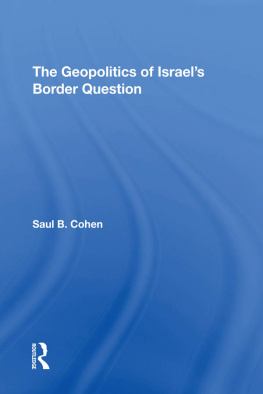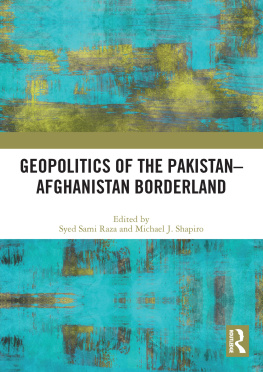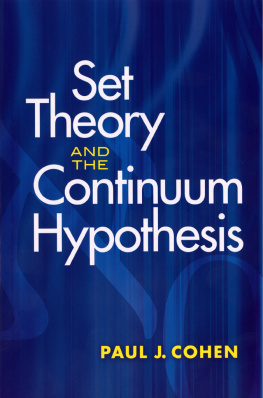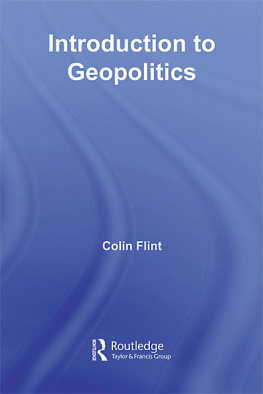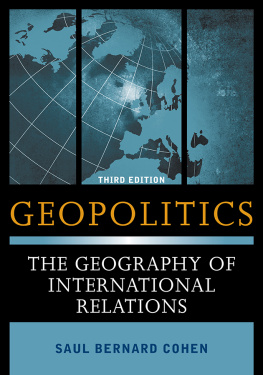First published 1986 by Westview Press
Published 2019 by Routledge
52 Vanderbilt Avenue, New York, NY 10017
2 Park Square, Milton Park, Abingdon, Oxon OX14 4RN
Routledge is an imprint of the Taylor & Francis Group, an informa business
Copyright 1986 Taylor & Francis
All rights reserved. No part of this book may be reprinted or reproduced or utilised in any form or by any electronic, mechanical, or other means, now known or hereafter invented, including photocopying and recording, or in any information storage or retrieval system, without permission in writing from the publishers.
Notice:
Product or corporate names may be trademarks or registered trademarks, and are used only for identification and explanation without intent to infringe.
ISBN 13: 978-0-367-29250-8 (hbk)
Derech road
Emeq valley
En, Ein spring
Eretz Yisrael Land of Israel
Eretz Yisrael HaShlema the entirety of (Biblical) Israel; Greater Israel
Gesher bridge
Har mount, mountain
Hevel region, district
Jebel mount, mountain
Kfar village
Kvutza, kibbutz (pl. kvutzot, kibbutzim) forms of agricultural collective
Mitzpe overlook, observation point
Moshav (pl. moshavim) agricultural cooperative
Moshava agricultural colony
Nahal river
Shephela coastal plain, lowland
Wadi valley, gulch
Yam sea, lake
Yishuv settlement
A nation at war with its neighbors must seek every possible strategic and tactical advantage. Even in this age of long-range missiles and space weaponry, and of high technology communications and intelligence-gathering gear, control of particular pieces of territory can prove decisive both militarily and politically.
When a nation is at peace with its neighbors, the tactical and strategic character of its borders has no military consequences. Of course, command of unique land and water areas may provide economic advantage to one side, and help it to regulate its affairs and enforce its laws more easily. But control of a few square meters or even kilometers of territory is hardly a matter of national survival.
Israel, however, is a nation whose continuing state of belligerency with its neighbors has been punctuated by seven wars. In its pursuit of peace, it faces a difficult dilemma with respect to the question of territory and borders. It must be open and forthcoming in negotiations, particularly with respect to the territory that it would be prepared to return in exchange for a formal peace agreement. However, in such negotiations, it must also seek the maximum territorial advantage that diplomacy can gain, as protection against possible future repudiation of such an agreement. But how much territory? Which particular portions? What special legal territorial arrangements? These are questions that should emerge in a serious public debate about the wisdom of entering into negotiations, and would become the essence of the negotiations themselves. Insisting upon holding on to too much of the territories gained in 1967 could undermine the prospects for a successful peace agreement. Retaining too little of the land that was acquired could endanger future generations should a peace agreement prove ephemeral.
In this volume, the complexities of the territorial imperative are addressed. The definition of secure borders for Israel is a geopolitical topic. Geopolitics involves complex and interrelated elements in the relationship of peoples to their environments - military, economic, social, political and psychological. These need to be known and understood by both the Israeli and the Palestinian Arab publics, should conditions in the international arena and the Arab camp create either pressures or opportunities for Israel to negotiate a peace based upon United Nations Resolution 242.
In recent history, there are few parallels to the Arab-Israeli conflict: it revolves around mutual challenge both to national sovereignty and to territorial boundaries. Israels willingness to engage in territorial compromise does not guarantee Arab agreement on the sovereignty issue, but without an expressed willingness, discussions over such an agreement cannot even begin.
The Land of Israel has experienced two stages of division, and is now in its third. The first partition, in 1922, separated Transjordan from Western Palestine. The second partition, in 1949, was the product of the armistice agreements between a newly established Israel and surrounding Arab states. In 1967, the third stage of partition was initiated by Israels conquest of the West Bank and Gaza Strip, Sinai and the Golan Heights. Although Sinai and a small part of the Golan were subsequently returned, the political border between Israel and its neighbors will remain in a state of flux until Israels territorial security needs and sovereign being are recognized by the Arabs. In exchange, Israel will have to offer the Palestinian Arabs of the West Bank and Gaza Strip a political vehicle for satisfying their desires for self-determination, and to offer Syria a compromise on the Golan.
This study addresses possible border adjustments between Israel and a potential Palestinian political entity, and with Syria on the Golan. The factors influencing proposed territorial adjustments once the mutual sovereignty issue is resolved are of both a strategic-tactical and demographic-economic nature. These include defensive depth, surveillance points, marshalling areas and corridors, water control space for Israeli population and industrial growth, absence of dense Arab populations, and psycho-tactical space.
The proposed map of territorial compromise requires border adjustments in nine different sectors along the Green Line that once separated Israel from the Jordanian-held West Bank, for a total of 1,165 km2. In the Gaza Strip, 70 km2 are recommended for retention by Israel, and in the Golan Heights, 600 km2. In addition, a lower Jordan Valley Security Zone of 450 km2 is proposed which Israel would hold on a long-term lease, for military and settlement purposes.
Three multi-national corridors are also contemplated - Wadi Faria, Jericho-Jerusalem and Med-Dead/Hebron. They cover 200 km2 in Judea and Samaria, and 250 km2 in the northern Negev. These would be corridors of assimilation to promote interaction between Israel, the Arab West Bank and Jordan. They would be customs-free demilitarized zones, and are intended for uses such as regional interconnection, transportation, industry, tourism and recreation, water storage, warehousing and marketing.
All told, the suggested territories to be annexed by Israel represent twenty percent of Judea and Samaria, nineteen percent of the Gaza Strip, and half of the Golan Heights. The lower Jordan Valley Security Zone, and the two corridors traversing Judea and Samaria represent another twelve percent of those territories.
These territorial adjustments are related, in part, to the geographical expansion needs of the Israeli core area. With the growth of population into the twenty-first century, Israels ecumene, or population and economic core, is likely to be extended from its present central coastal plain location northward beyond Haifa, southward to Beersheba and thence to the Gaza Strip-North Sinai borders, and eastward through the Jerusalem corridor to Jerusalem. Optimally, expansion of the ecumene also requires lands on the western flanks of Samaria and Judea.

